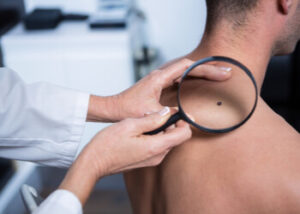Why Early Detection Matters
Skin cancer usually develops in skin cells that have been exposed to UV rays. Using sun protection helps to safeguard you against this risk but early detection and treatment are essential for successful treatment. You can also check your skin yourself, and report any abnormalities to your general practitioner for further inspection.
There are three primary types of skin cancer of concern:
Basal cell carcinoma and squamous cell carcinoma. They are common but not as likely to spread to other parts of the body.
Melanoma starts in the skin and then spreads to other parts of the body. It is the most aggressive form of skin cancer but 95% of the time it can be treated successfully.
Skin checks are important because skin cancers do not usually present with other symptoms. Becoming familiar with your freckles and moles is important, and any unusual changes can be referred to your doctor.
Who Is At Risk Of Developing Skin Cancer
Essentially, everyone is at risk of skin cancer because we are exposed to the sun’s rays all the time, but your risk increases as you get older. In fact, 66% of Australians will have been diagnosed with skin cancer by the time they turn 70. Other factors that can increase your risk profile include
- A family history of skin cancer
- Fair skin
- Regular or severe sunburn
- Tanning beds and sun lamps
- Working outdoors or playing sport
- A compromised immune system.
Warning Signs That Need A Skin Check
The research shows that most melanomas are detected by patients or members of their families, so becoming familiar with and checking your skin can really make a difference. Other warning signs to look out for include
- New spots
- Moles or freckles that change shape, colour or texture over time
- Sores that develop a crust and do not seem to heal
- Sores that bleed or are itchy
In the case of melanomas, you also want to investigate
- Moles that are asymmetrical
- Moles or freckles that have uneven or scalloped borders
- Moles that have different colours throughout them
- Lesions that are bigger than 6mm or smaller than 6mm but growing noticeably
How Does A GP Do A Skin Check?
Your GP will have a conversation with you about your lifestyle and history to establish your risk.

Don’t wear eye makeup so your GP can check the skin in and around your eyes.
If there is a suspicious mark your general practitioner will take a biopsy for further investigation. This means removing part of a growth or lesion to send to the lab where the relevant tests will be done. Your general practitioner may also refer you to a skin specialist or dermatologist if he or she has cause for concern
How Often Should You Get Skin Checks?
Unless you fall into the high-risk categories identified above, skin checks can be performed by your GP once a year. If you are at increased risk, a medical check-up is recommended every six months. It is good practice to get into the habit of doing your own skin checks every two-three months, particularly if you have cause for concern.
How To Protect Yourself Against The Sun
Make sure you wear sunscreen with an SPF of 30 or greater every day, even when it is overcast. The UV index can be even higher on a cloudy day and, even if the sun isn’t shining through, its UV rays are still coming into contact with you. UV rays are responsible for 95% of skin cancer diagnoses.
Skin that is not protected from the sun gets damaged. It makes changes to the cells and their behaviour, which can accumulate and lead to permanent damage.
If you can avoid being in the sun, opt for shade rather. If you are in the direct sun, wear an oversized hat and sunglasses. When the weather is very hot it’s more protective to wear thin, long-sleeved shirts with higher necklines than sleeveless shirts and vests.
Avoid tanning beds and sun lamps as they present unnecessary skin exposure. Not only are UV rays harmful to your health, but they also age your skin faster and dehydrate you too.
If you have any skin concerns or want to know more about how often should you get skin checks, it’s best to seek professional input as soon as possible as early detection and treatment give you the best chance of a successful outcome. Please contact us
REFERENCES
Should I be checked for skin cancer?
Checking for skin cancer
https://www.cancercouncil.com.au/cancer-prevention/screening/checking-for-skin-cancer/
Annual Exams
Five Easy Steps to Prepare Yourself





